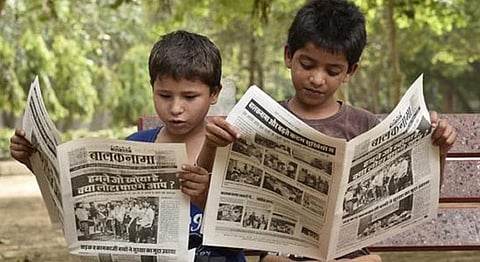
- HOMEGROWN WORLD
- #HGCREATORS
- #HGEXPLORE
- #HGVOICES
- #HGSHOP
- CAREERS
- ABOUT US
- CONTACT US

“Since my photo got published in Balaknama, I’m much more interested in studying and reading.”
Jyoti, who lives under a bridge at a bus stop in Delhi, has been extremely motivated since she saw her photo published in Balaknama in 2012. Rag-picker by day, she works as a journalist with a publication that is planned, written and edited by kids who work on the streets, and in factories. Balaknama, read by 10, 000 readers across four states in the country, publishes stories and editorials by children who are mostly ragpickers, or help their parents in their jobs like working in households or selling vegetables. The unique quarterly newspaper will complete 14 years this July, the first and only of its kind in the country.
“We started with a group of 35 street and working children in 2003. Now, there are more than 10,000 of us across India,” recalls Subhash of Chetna (Childhood Enhancement through Training and Action), the Delhi-based NGO whose initiative this is. They also offer support groups and workshops to help children deal with trauma, provide counselling, healthcare services and drug rehabilitation.
”We simplify complex issues in the paper so that kids take interest in it,” said 19-year-old Shanno, the editor from Sunder Nagari slum, who interviews street kids and tells their stories. Having joined the newspaper when she was 11 after previously worked in a garment factory and learning to read in outdoor charity classes, she assures her mother that a bright future is in the offing. Her father passed away last year and her mother works as a seamstress, and she is often worried about how to procure funds for Shanno’s education. “Don’t worry. I’ll get an education and then we’ll have everything,” she assured.
The newspaper does not only create a safe space to voice the issues of the children involved in child labour, but it equips the kids with a sense of purpose and empowers them, with a focus on issues that affect them personally, like child marriage, abuse and police brutality. In fact, Chetna’s director Sanjay Gupta says that writing for Balaknama helps the young people heal from the distress and suffering they have experienced. Sold for Re 1, the paper runs on a contribution of Rs 5 per month from each kid, that helps in both funding their basic education, as well as the production of the newspaper, while a large part of it is run on the sponsorship of a federation for street children in northern India, called Badhte Kadami.
”The monthly contribution fee ensures that each child feels a sense of involvement. Even those children who are still learning to read and write insist that the stories in the paper are read out to them by others,” says Subhash, himself a street kid who used to sell magazines at traffic intersections, who has now completed his graduation in social work.
20-year-old Vijay, who used to work in a wood-carving unit in Delhi’s Kirti Nagar, encapsulates the essence of Balaknama’s power best when he professes his hope that some new children from the team will soon fill in their shoes, and continue to teach more kids how to read and write. “I’m very happy that Balaknama will reach out to so many kids and those children will become powerful. From those, a few will emerge as the future editors of the magazine,” he says.
